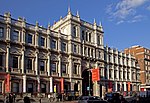Royal Academy Summer Exhibition

The Summer Exhibition is an open art exhibition held annually by the Royal Academy in Burlington House, Piccadilly in central London, England, during the months of June, July, and August. The exhibition includes paintings, prints, drawings, sculpture, architectural designs and models, and is the largest and most popular open exhibition in the United Kingdom. It is also "the longest continuously staged exhibition of contemporary art in the world".When the Royal Academy was founded in 1768 one of its key objectives was to establish an annual exhibition, open to all artists of merit, which could be visited by the public. The first Summer Exhibition took place in 1769; it has been held every year since without exception.
Excerpt from the Wikipedia article Royal Academy Summer Exhibition (License: CC BY-SA 3.0, Authors, Images).Royal Academy Summer Exhibition
Piccadilly, City of Westminster Mayfair
Geographical coordinates (GPS) Address Phone number Website Nearby Places Show on map
Geographical coordinates (GPS)
| Latitude | Longitude |
|---|---|
| N 51.5092 ° | E -0.1401 ° |
Address
Royal Academy of Arts (RA)
Piccadilly
W1J 0BD City of Westminster, Mayfair
England, United Kingdom
Open on Google Maps










